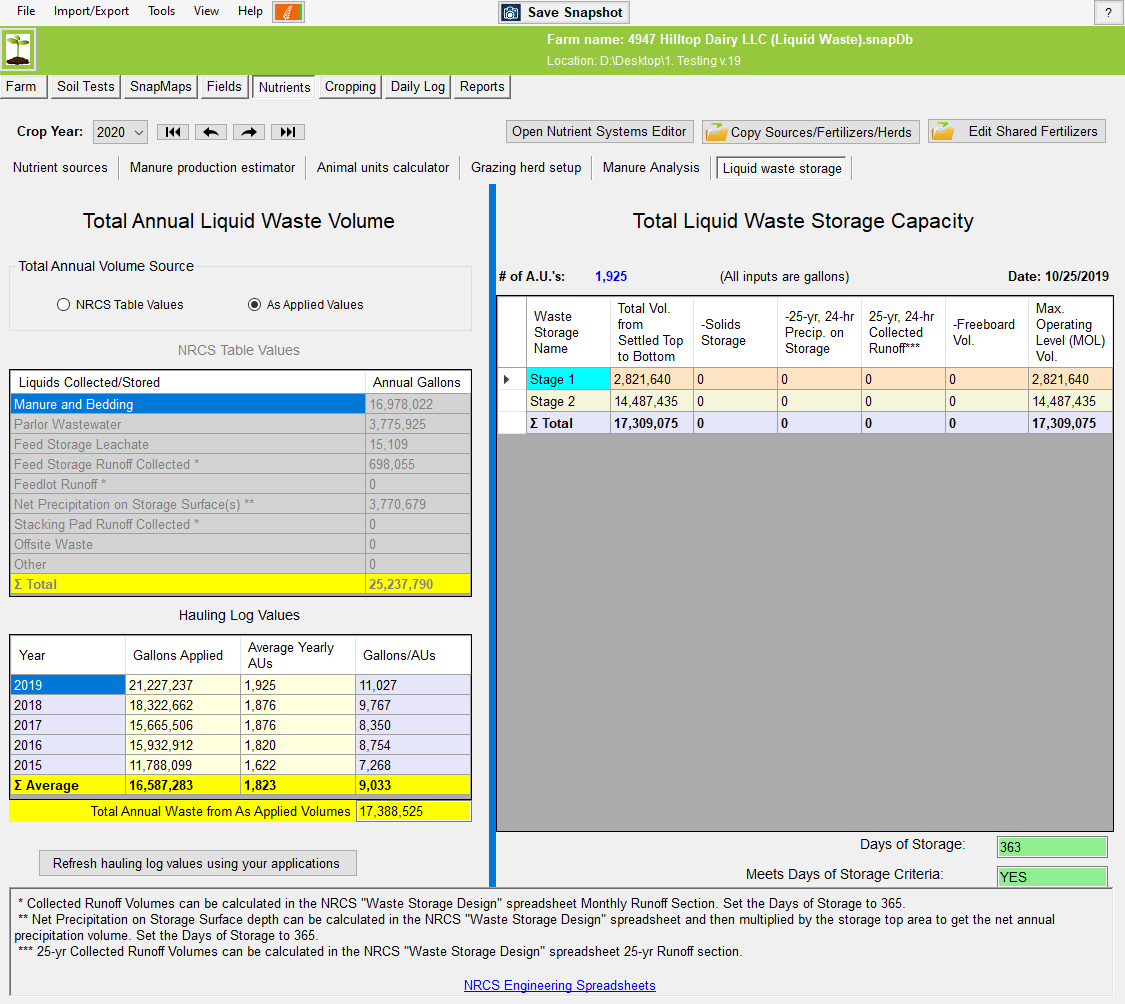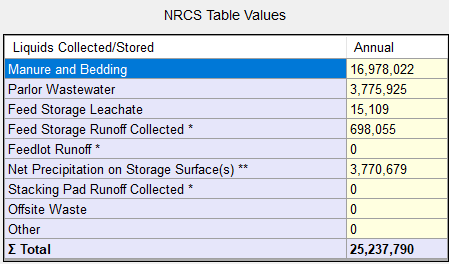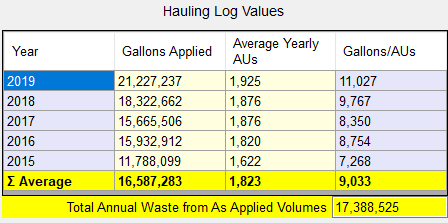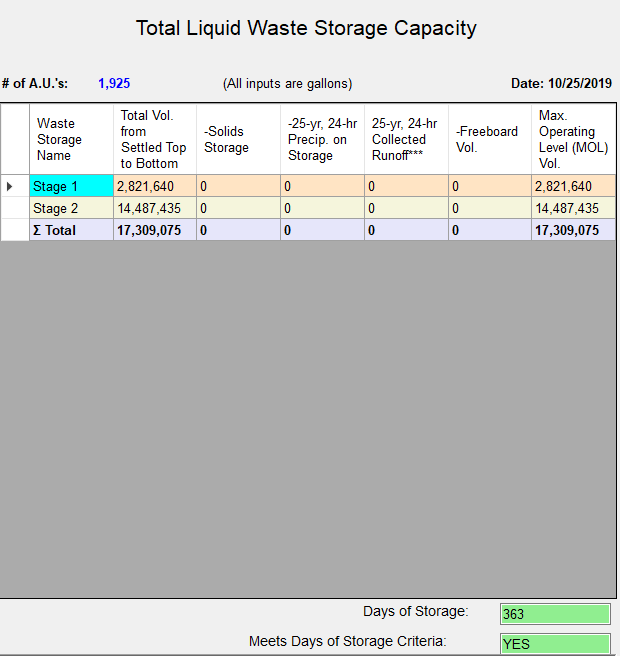Liquid Waste Storage |

|

|
|
Liquid Waste Storage |

|

|
|
|
||
The purpose of the Liquid Waste Storage TAB is to determine whether there is enough storage capacity to handle the liquids generated and stored on an annual basis.
It’s important to know how much storage there is on site for nutrient management planning purposes. Calculating the number of days of storage provides an estimate of how many days your facility can go without having to spread any manure with the existing amount of storage on site. This is an estimated value as the calculation uses an average annual rainfall value and the amount of rain received changes each year. If the farm is a CAFO, DNR staff will review the days of storage calculations for compliance with the 180- day storage requirement of NR 243.

Two spreadsheets allow you to determine the amount of liquids you generate each year - the Total Annual Liquid Waste Volume and the Hauling Log Values spreadsheets. The Total Liquid Waste Storage Capacity spreadsheet is used to fill out more information about the liquid storage units you have defined on the SnapPlus Nutrients Manure Production TAB. Once all of the data, including the # of A.U.’s, is provided you may use either the NRCS Table Values or the Hauling Log Values as the amount of liquid on the farm to calculate the Days of Storage and whether you meet the days of storage criteria.

Toggle between activating the associated grids. When a grid is active you may edit the values and it is used as the source of your Total Annual Liquid Waste Volume to calculate the Days of Storage 363 and Meets Days of Storage Criteria YES values in the lower right of the screen.
![]() - Click this button to populate the Hauling Log Values grid with the liquid applications you’ve recorded for the past five years.
- Click this button to populate the Hauling Log Values grid with the liquid applications you’ve recorded for the past five years.
The bottom of the tab has an NRCS Engineering Spreadsheets link. Click the link and scroll to the bottom to find the NRCS Waste Storage Design spreadsheet. Once opened, there is a Help tab available.
Total Annual Liquid Waste Volume
NRSC Table Values are entered in gallons per year.

Manure and Bedding – Total annual generation value for maximum number of animal present at an operation during the year. Calculated from the expected average daily manure and bedding that each head of livestock produces multiplied by number of head and days they are on site for the year.
Parlor Wastewater – Wastewater that is directly or indirectly used in the operation of animal feeding operations. Calculated based on operational factors or using default values for expected animals on site.
Feed Storage Leachate – The calculated 30- day volume of leachate generated by the amount of feed stored on site. Calculation is 0.5 cu. ft. of leachate per ton of stored feed (can use 33.3 cu. ft. per ton of stored feed).
Offsite Waste – Waste that is brought to the farm from an offsite source. Examples include food processing waste.
The runoff and precipitation cells, asterisk cells, may be calculated using the NRCS “Waste Storage Design” spreadsheet found at the following webpage: https://www.nrcs.usda.gov/wps/portal/nrcs/detail/wi/technical/engineering/?cid=nrcs142p2_025422
•Feed Storage Runoff Collected * - Annual runoff from feed storage areas on site collected in a waste storage facility.
•Feedlot Runoff * - Annual runoff from feedlot areas on site collected in a waste storage facility.
•Stacking Pad Runoff * - Annual runoff from stacking pads on site collected in a waste storage facility.
•Net Precipitation on Storage Surface ** - Volume of annual precipitation minus evaporation that falls on each waste storage facility.
Hauling Log Values may be pulled from your liquid applications initially and then edited as you wish to be as accurate as you can. With the current year being 2020, the previous five years data is represented in this grid.

Year – Previous year automatic and read only.
Gallons Applied – Enter the gallons applied to your or other fields.
Average Yearly AUs – Animal units
Gallons/AU – Calculated and read only.
∑ Averages - do not use rows with zero values.
Total Annual Waste from As Applied Volumes – Average Gallons/AUs * # of A.U.’s
Total Liquid Waste Storage Capacity

# of A.U.'s - The number of animal units for the current year.
Date: Current date - read only.
Waste Storage Name - Storage units defined in SnapPlus on the Nutrients | Manure production estimator tab. Additional storage units must be defined in SnapPlus before they will appear in this grid.
Total Vol. from Settled Top to Bottom – The total volume of the waste storage facility from the top to the bottom of the structure.
Solids Storage – Depth of solids and liquids not removed from each waste storage facility. The additional storage depth can be reduced if a sump is installed or other provisions to empty the facility have been made.
25-yr, 24-hr Precip. on Storage – 25-year, 24-hour precipitation on the top area of the liquid storage facility.
25-yr, 24-hr Collected Runoff *** – 25-year, 24-hour runoff from areas which directly drain to the waste storage or have runoff collection systems which deliver runoff to the waste storage. *** 25-yr Collected Runoff Volumes can be calculated in the NRCS Waste Storage Design spreadsheet 25-yr Runoff section.
Freeboard Vol. – Remove a minimum of one foot of depth from the settled top to the design or if existing, constructed storage volume to reduce the risk of over-topping. The volume in the freeboard depth on the top of the waste storage to reduce the risk of over-topping. The freeboard depth is typically one foot below the settled top of the storage.
Max Operating Level (MOL) Vol. = Total Vol. from Settled Top to Bottom – Solids Storage – 25-yr, 24-hr Precip. on Storage – 25-yr, 24-hr Collected Runoff – Freeboard Volume
Days of Storage – Calculated based on the (Total MOL Volume)/(Total Annual Waste)*365 days
Meets Days of Storage Criteria – CAFO permits require that facilities have a minimum of 180 days of available storage. If the days of storage calculation show at least 180 days of available storage on site, then the facility meets days of storage criteria and this will show YES.